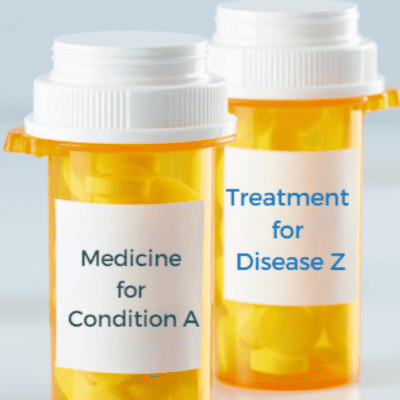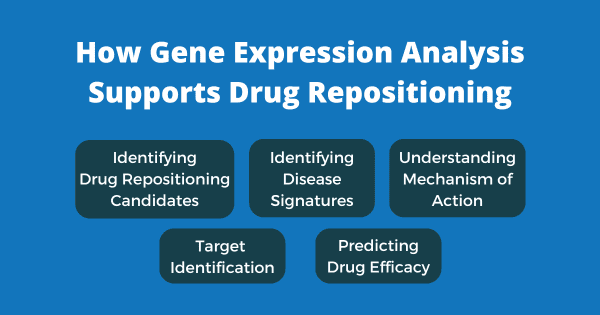Drug Repositioning With Gene Expression Analysis
- 19th March 2024
- Posted by: Breige McBride
- Category: Gene Expression Analysis

Since gene expression analysis provides insights into the molecular mechanisms underlying diseases and drug responses, there are several ways it can help with drug repositioning. For example, it can help with identifying drug repositioning candidates, target identification and predicting a drug’s efficacy for treating diseases. You can learn more about each of these, as well as other ways gene expression analysis supports drug repositioning, below.

Identifying Disease Signatures
We can use gene expression analysis to identify gene expression patterns associated with particular diseases. By comparing gene expression profiles of healthy and diseased tissues, we can pinpoint genes and pathways dysregulated in the disease state. These insights can then support target identification as explained below.
Target Identification
After identifying disease signatures, gene expression analysis can assist with prioritising potential therapeutic targets. By noting the genes that are consistently dysregulated across different studies or patient populations, we can create a shortlist of potential targets for drug development or drug repositioning.
Drug Mechanism of Action
Gene expression analysis also helps with understanding how drugs affect the body. It allows us to compare the gene expression profiles of cells or tissues before and after drug treatment. Such comparisons allow us to figure out the pathways and molecular processes the drug affects. This information can help in understanding the drug’s mechanism of action, and predicting its efficacy in treating different diseases.
Identifying Drug Repositioning Candidates
Gene expression analysis enables comparison between gene expression profiles of diseased tissues and those treated with different drugs. Such comparisons help to identify drugs that induce gene expression changes that could rectify or compensate for those observed in the disease state. Researchers can then investigate these drugs for their potential therapeutic benefits.
Why is Drug Repositioning Important for Drug Developers?
Drug repositioning, also known as drug repurposing, refers to finding new uses for existing drugs. This can be particularly lucrative for the drug’s developer. It is so lucrative because repositioning a drug to treat a condition other than the one it is currently used for, can extend the length of the drug’s patent. Consequently, this may give the drug developer more years of drug exclusivity, allowing them more time to profit as much as possible from the drug. What’s more, it costs significantly less to reposition an existing drug than it does to develop a new drug. In fact, the cost of developing a new drug is estimated to be between $2-3 billion, while bringing a repositioned drug to market is estimated to be much less, around $300 million.1
Drug Repositioning: Advance Your Research With Gene Expression Analysis From Fios Genomics
As a leading bioinformatics provider, our bioinformaticians have extensive experience analysing gene expression data to produce actionable conclusions to support drug discovery, development and repositioning. We have been providing these invaluable insights to pharmaceutical, biotechnology and academic organisations for over 15 years. Some of our recent gene expression analysis projects include:
- Identification of gene expression signatures associated with response to treatment
- Associating drug response with changes in expression profiles to identify potential mechanisms of response to treatment
- Investigating the effect of drug treatment on the expression profile of a cancer cell line over a time course
If you would like to discuss a gene expression analysis or drug repositioning project, contact us today!
Alternatively, if you would like more information before getting in contact, visit our Gene Expression Data Analysis service page. Also, we have an example report available which demonstrates what you can expect from a Fios Genomics gene expression data analysis report. You can request this report using the form below.
Request A Sample Report
This sample report describes the analysis of publicly available RNA sequencing (RNA-Seq) dataset GSE47944 obtained from the NCBI GEO website. The aim of this study was to identify genes and pathways associated with psoriasis and the response of psoriatic skin to modulation of the AhR.
1 Nosengo, N. Can you teach old drugs new tricks? Nature 534, 314–316 (2016)
Author: Breige McBride, Content and Social Media Manager, Fios Genomics
Reviewed by Fios Genomics Bioinformatics Experts to ensure accuracy
You may also be interested in:
How Fios Genomics can Help With Drug Repurposing
Bioinformatics Analysis of NGS Data

